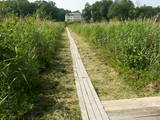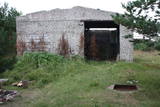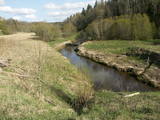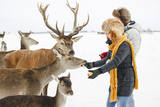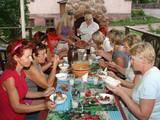| Нo | Название | Описание |
|---|---|---|
|
Atrodas ļoti skaistā vietā – Krimuldas muižas kompleksa teritorijā, vienā no muižas vēsturiskajām ēkām. Mājīgs interjers, mākslinieka J. Annmaņa apgleznotas sienas. Piedāvā turpat muižā darinātos mājas vīnus un „Muižas stipro”. Garšīgas tējas, uzkodas un siltie ēdieni. |
||
|
Из Рижского аэропорта тур ведет прямо за город, в усадьбу Яунмоку, окруженную красивым парком. А на следующий день начинается наблюдение за птицами в Национальном парке Кемери, включая заболоченные территории и территории вокруг озера Каниерис и деревни Кемери. Затем маршрут следует вдоль западного побережья Рижского Залива, делая на пути небольшие остановки и включая более длительные прогулки в Мерсрагсе. Затем вы проведете некоторое время на мысе Колка и в его окрестностях, которые считаются основным местом миграции. Посетите широколиственные леса Национального парка Слитере вокруг древнего побережья Балтийского Ледового моря и проедьте сквозь пойменные Ужавские луга, затем сделайте остановку в самой западной точке страны, Акменьрагсе. Маршрут продолжается в Лиепае и Орнитологической станции Папе и озере, где есть возможность провести ночь, наблюдая за миграцией сов, если она уже началась. Затем мы проедем через лесную территорию Зварте и остановимся несколько раз на рыбных прудах на пути обратно в Ригу. |
||
|
The best place to look at the restricted area of the Vīķi swamp and the Lielauce lake which is in the middle of that swamp is the Lielauce castle, where a wooden pathway stars. The pathway will lead visitors across the swampy shores of Lake Lielauce and deliver them at a boating area on the open part of the lake. The swamp itself is to the South-east of the lake. The restricted area is there to protect biotopes and species in the area. |
||
|
Находится в центре Барты, рядом со средней школой. В основной экспозиции музея «Бартские традиции изготовления и ношения народного костюма в XIX – XX столетии» представлены девичьи, женские и мужские наряды и их разнообразие. Посетители могут принять участие в процессе ткачества и вышивания орнамента на бартских рубахах. Вместе с этнографическим ансамблем «Барта» предлагается участие в образовательных программах «Народные костюмы Барты» и «Поют женщины Барты». |
||
|
Dvietes un netāli esošais Skuķu ezeri ir vieni no teritorijas grūti pieejamajiem palieņu ezeriem – lielākie šāda tipa
ezeri Latvijā. Palu laikā pārplūst, savienojoties vienā lielā ūdenskrātuvē.
|
||
|
Saimniecībā tiek audzētas gaļas šķirnes (Suffolkas) aitas un piena šķirnes (Ostfrīzijas) aitas. Ganāpmulka aizsardzībai saimniecībā strādā ar sargsuņiem, Pireneju kalnu suņiem, kas ir pasaulē arī plaši pazīstama suņu šķirne mājlopu un mājputnu apsargāšanai no lielākiem un mazākiem plēsējiem. Saimnieki piedāvā iegādāties premium klases, saimniecībā audzētu, jēru gaļu un aitu piena produktus- Fetas tipa sieru, grilsieru, jogurtu bez piedevām un vairāku veidu saldējumus. |
||
|
This tower is on the shores of the ancient Litorine Sea, with a lovely view of the unique seashore here – complete with small bays and capes. It is part of the Kaltene nature trail, which is around one kilometre long. The location is of particular interest during spring or autumn migration of birds. Two other bird-watching platforms are nearby.
|
||
|
Puises ragā (Puise nina) ir uzcelts divstāvīgs atpūtas nams, kas apvienots ar putnu vērošanas torni. No tā paveras skats uz piekrasti, kas ir iecienīta migrējošo zosu atpūtas vieta. Šī ir privāta teritorija, kuras apskati vēlams saskaņot ar īpašnieku. |
||
|
Находится в историческом центре Лудзы, откуда открывается красивый вид на храмы города и городище. Готовят латгальские блюда из местных продуктов. Латышская кухня: Серый горох с салом, по-разному приготовленная свинина. Особое блюдо: «Угощение от хозяина» - мясное и куриное филе с сыром и медовым соусом. |
||
|
В пункте погранохраны берега Лабрагс сохранились помещения для прожекторов. Объект находится в частной собственности.
|
||
|
Auch Königstor (Kuningavärav) genannt. Im Barockstil gebaut ist ein Teil der früheren mittelalterlichen Stadtbefestigung. Der Beginn des alten Postweges. |
||
|
This tour will take you exploring the peculiar island of Rusnė and the delta of the river Nemunas in Lithuania. The island of Rusnė in the Nemunas Delta Regional Park is enclosed by waters of the river Nemunas and its tributaries. It is a resting place for migratory birds and home to a cormorant colony. The area of the island is 45 km2 and it is connected to the mainland by a bridge. The island of Rusnė is the lowest place in Lithuania, lying below sea level. The historic centre of the town Rusnė is characteristic of authentic wooden architecture, buildings painted in bright colours, colourful window shutters and decorations. The Baltic Coastal Hiking Route leads through the small town of Šilutė, revealing architecture that was once common to East Prussia. From Šilutė to Kintai, the Baltic Coastal Hiking Route runs along a low plain. To protect this area from flood waters of Nemunas, there is a system of dams, polders and canals established. After crossing the river Minija, the route invites you to visit the ethnographic village of Minija. Here you can enjoy the lowland landscape of the seaside region with vast wetlands and ponds. |
||
|
Das in 1671 gebaute Schloss wurde mehrmals umgebaut und die heutige Aussicht im Stil des Klassizismus hat das Schloss 1820 – 1923 erhalten. Der im 19. Jh angelegte Park mit einer Rotunde und einer Steinbrücke. Tematische Ausstellungen. |
||
|
В хозяйстве выращивают и предлагают саженцы овощей и однолетнюю цветочную рассаду, многолетнюю цветочную рассаду, а также саженцы декоративных кустов и деревьев. Разрабатывают проекты садов и насаждений, предлагают рассаду, принимают заказы на выращивание рассады. Интересующиеся узнают секреты выращивания декоративных растений, получат советы. |
||
|
Riežupes dabas parks veidots g.k. Riežupes izteksmīgās ielejas, tai raksturīgo dabas vērtību – nogāžu un gravu mežu, dažādu ģeoloģisku dabas pieminekļu - smilšakmens atsegumu, alu, ūdenkritumu, upes straujteču posmu, dažādu sugu, mežu masīvu un ainavas aizsardzībai. Parka atrodas viens no Kurzemes populārākajiem tūrisma objektiem – Riežupes alas - garākais mākslīgo alu labirints Latvijā, kura eju kopgarums ir 460 m. Sākotnēji dabas veidotās alas 19. gs. vidū mākslīgi paplašināja baltās smilts ieguves nolūkos, kuras izmantoja stikla ražošanai. Parkā izveidots velotūrisma maršruts. |
||
|
«Бароно вила» - это райский уголок: широкий и глубокий пруд с рыбками, пасущиеся в загонах олени и даниэли, овцы, богатые грибами и ягодами леса, прозрачные озера, а также полюбившиеся туристам изгибы реки Швянтойи. В ресторане усадьбы подают свежую, вкусную и качественную еду, изысканные блюда из оленины, баранины и мяса даниэлей, запеченные в печи литовский ржаной хлеб и приготовленное на костре фирменное блюдо – «Плов Барона». |
||
|
Торфяной железобетонный завод.
Сейчас с этого места открывается
заброшенный и своеобразный
промышленный ландшафт. Проезжая через
территорию завода, следите за
маркировкой.
|
||
|
Корчма находится в центре столицы суитов Алсунге. Суиты всегда любили хорошо поработать, хорошо спеть и хорошо поесть! Хозяйки «Спелманю крогса» предлагают группам отведать приготовленные по старинным рецептам древних суитов блюда, а также всем вместе освоить приготовление скландраушей, клецок, скабпутры и других блюд этой стороны. Трапезу сделает незабываемой эффектное выступление женщин-суитов. Можете купить скландрауши и кислый хлеб, который пекут только у нас. Латышская кухня: Кисло-сладкий хлеб, клёцки, копченые рёбрышки. Особое блюдо: Домашние скландрауши. |
||
|
Manufacture of sausages and smoked pigs. For pig feed, the farm uses home-grown grains (not treated with glyphosates) and unmodified soybeans grown by the farm itself. Sausages and smoked meat and spices. Only natural alder firewood is used in the smoking process. |
||
|
Хозяйка встретит вас небольшим рассказом о выращенном в хозяйстве здоровом травяном чае и испеченными ею лакомствами. Если есть желание провести ночь под открытым небом, мы предлагаем места для палаток и костров, расположенные на берегу реки возле старой мельницы Луку. Крестьянское хозяйство «Аплоки» ждет каждого, кто хочет отдохнуть в тихой и спокойной атмосфере. |
||


